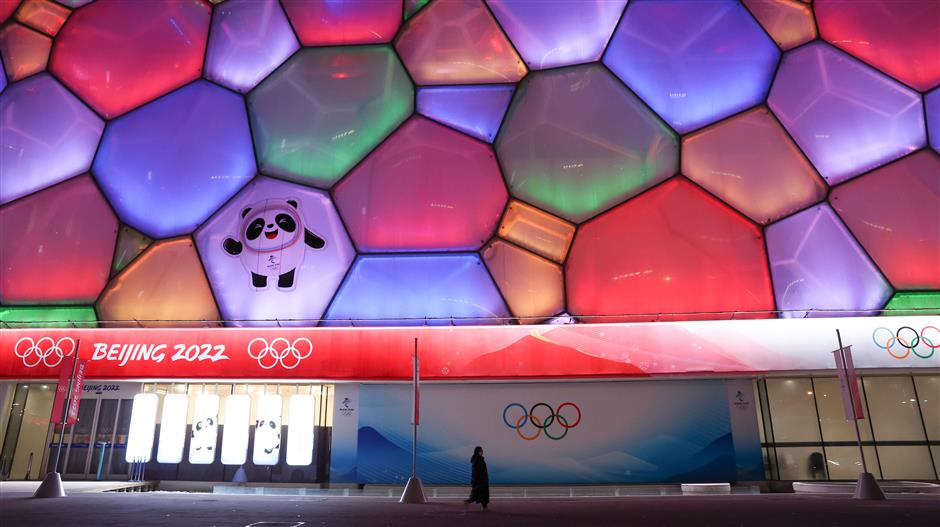Green Beijing 2022: Embracing a shared future for all on Earth
About 3,000 athletes from around the world are competing in 109 events at this year's Winter Olympics in Beijing, from ski jumping to speed skating.
After the Tokyo 2020 last summer, the Beijing 2022 is the second Olympic Games to take place during the coronavirus pandemic, and the first to be carbon neutral.
The only city to have hosted both Summer and Winter Olympics, Beijing is keen to make a statement about practical action to protect the environment and embrace a shared future for everyone and everything on Earth.
The climate emergency – rising sea levels, increased aridity in the northern plains already beset by a water crisis, food security issues and more – makes green growth a vital concern for all countries and regions.
Indeed, rising temperatures around the world pose an existential threat to winter sports. According to researchers from the University of Waterloo, global warming trends will make the Winter Olympics unviable at all but one former host venue – Sapporo in Japan – by 2100. In this context, Beijing's effort to create a green Olympics is a step toward helping save winter sports and tackling global climate change.

Above and below: The National Aquatics center, which was the swimming and diving venue for the 2008 Beijing Summer Olympics, was frozen into the "Ice Cube" for the 2022 Winter Olympics. It hosted the curling events.

China Environment News reported on February 4 that all the Beijing 2022 venues use "green electricity" generated from recyclable sources such as wind, solar and hydraulic power. The newspaper called it "a breakthrough in the history of Olympic Games."
According to a report published on Nature's website on February 4, China has reduced emissions by retrofitting buildings from the 2008 Summer Games, using renewable power and procuring vehicles fuelled by hydrogen, natural gas and electricity.
"Previous Winter Olympics claimed to be carbon neutral, but the International Olympics Committee says that China is considering a much broader range of emissions. It has already invested heavily in renewable energy as part of its overall goal of achieving carbon neutrality by 2060," says the report.
The report quoted Marie Sallois, a director of sustainable development at the International Olympic Committee in Lausanne, Switzerland, as saying that "Beijing's Winter Games are the first to have considered a broad range of emissions from the earliest stages of preparation."
Beijing's approach of embedding sustainability at all stages of the process is "something we will encourage for future games," Sallois said.

The Big Air Shougang is part of an urban rejuvenation project that sees the 100-year-old Shougang steel plants transformed into the Beijing 2022 headquarters. It is the world's first permanent big air venue for long-term usage.
The wide use of "green electricity" is just one example of how Beijing has thrown its weight behind creating a green Olympics. As Reuters noted, all 25 venues for the Games, of which 13 are newly built, are deploying energy-saving technologies, including low-carbon building materials such as recycled cement and smart snow-making, which use 20 percent less water than traditional technologies.
CO2 collected from industrial waste gases is also used to cool ice rinks in four ice sports venues – a new technology replacing traditional hydrofluorocarbons that can damage the ozone layer.
Within the Olympic bubble, participants are transported on more than 1,000 hydrogen-powered buses. China is the world's largest hydrogen producer, with an annual production capacity of 41 million tons, and has been striving to make technological breakthroughs in storing and transporting the clean energy.
All these new technologies will change people's lifestyles in the future, leading to environmentally friendly living habits.
Moreover, any non-renewable energy use will be offset by afforestation. In Zhangjiakou, a city 180 kilometers northwest of Beijing that is hosting some skiing and snowboarding events, trees have been planted over an area of about 10,000 square kilometers to reach a net-zero target.

The Wukesong Sports Center in 2008 (top) and 2018 (above). Wukesong, home to the three-time Chinese Basketball Association champions Beijing Ducks, is no stranger to seasonal transformations, having staged the National Hockey League China Games in 2017 and Beijing's first-ever winter sports meet in 2018.
China's pledge of an environmentally sustainable Olympics is part of a national goal to hit peak carbon dioxide emissions before 2030 and reach carbon neutrality by 2060. As such, the Games are not just a demonstration zone for its eco-credentials, with the latest green technologies on display for a global audience, but a solid call for action to address climate change.
There is only one Earth for mankind. All countries should protect the environment and promote sustainable development. Building a shared future for humankind means widely sharing information on best practices. There's always room for improvement, and we all gain from continuous progress through mutual learning.
What China has done at the green Olympics should stimulate a global conversation over how best to achieve the goal of living in harmony with nature in a manner appropriate to different national contexts.
(Xu Haodong is a graduate student at the School of Journalism and Communication, Shanghai International Studies University.)
















